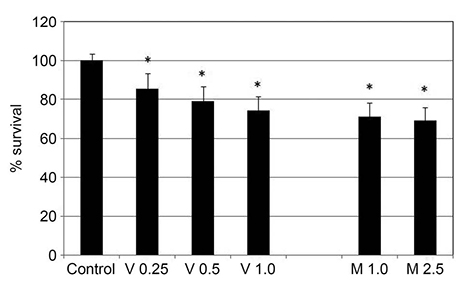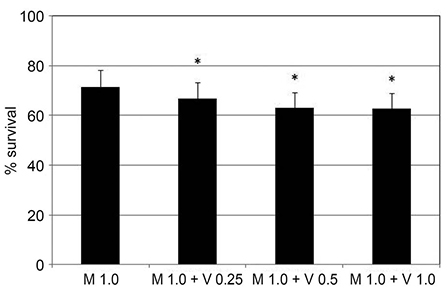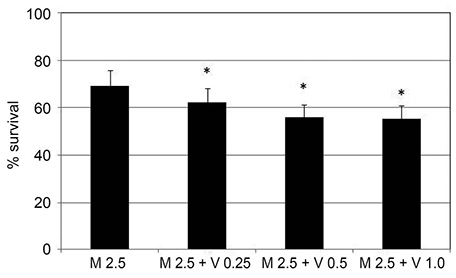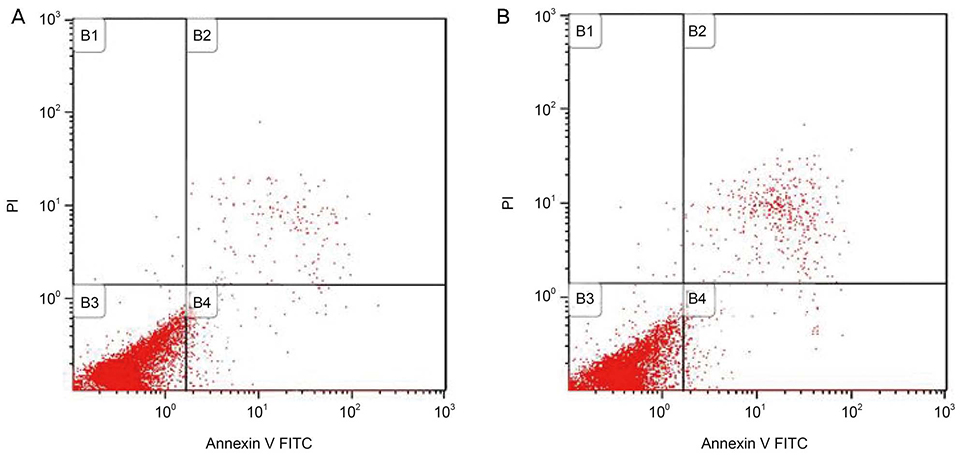J Korean Ophthalmol Soc.
2018 Nov;59(11):1056-1061. 10.3341/jkos.2018.59.11.1056.
Effects of Valproic Acid on the Survival of Human Tennon's Capsule Fibroblasts
- Affiliations
-
- 1Department of Ophthalmology, Daegu Catholic University School of Medicine, Daegu, Korea. jwkim@cu.ac.kr
- KMID: 2426367
- DOI: http://doi.org/10.3341/jkos.2018.59.11.1056
Abstract
- PURPOSE
To investigate the effects of valproic acid on the survival of cultured human Tenon's capsule fibroblasts (HTFBs).
METHODS
Primary cultured HTFBs were exposed to 0, 0.25, 0.5, and 1.0 mM valproic acid with or without 0, 1.0, 2.5 µg/mL mitomycin C, and incubated for 5 days. Cell survival was assessed using an MTT (3-[4, 5-dimethylthiazol-2-yl]-2, 5-diphenyltetrazolium bromide) assay and the degree of apoptosis was assessed by flow cytometry using annexin-V/propidium iodide double staining.
RESULTS
Valproic acid decreased the survival of HTFBs in a dose-dependent manner, and survival was further decreased by adding mitomycin C to valproic acid. Both valproic acid and mitomycin C induced apoptosis of HTFBs. Valproic acid induced less apoptosis than mitomycin C.
CONCLUSIONS
Valproic acid decreased the cellular survival of HTFBs and induced apoptosis. The antiproliferative effects of valproic acid were further enhanced by the addition of mitomycin C.
Keyword
MeSH Terms
Figure
Cited by 1 articles
-
Role of Hydrogen Sulfide in the Survival of Fibroblasts and Fibroblast-mediated Contraction of Collagen Gel
Hyeon Jin Park, Jae Woo Kim
J Korean Ophthalmol Soc. 2019;60(10):975-981. doi: 10.3341/jkos.2019.60.10.975.
Reference
-
1. Addicks EM, Quigley HA, Green WR, Robin AL. Histologic characteristics of filtering blebs in glaucomatous eyes. Arch Ophthalmol. 1983; 101:795–798.
Article2. Skuta GL, Parrish RK 2nd. Wound healing in glaucoma filtering surgery. Surv Ophthalmol. 1987; 32:149–170.
Article3. Bindlish R, Condon GP, Schlosser JD, et al. Efficacy and safety of mitomycin-C in primary trabeculectomy: five-year follow-up. Ophthalmology. 2002; 109:1336–1341. discussion 1341-2.4. Migdal C, Hitchings R. Morbidity following prolonged postoperative hypotony after trabeculectomy. Ophthalmic Surg. 1988; 19:865–867.
Article5. Zacharia PT, Deppermann SR, Schuman JS. Ocular hypotony after trabeculectomy with mitomycin C. Am J Ophthalmol. 1993; 116:314–326.
Article6. Fannin LA, Schiffman JC, Budenz DL. Risk factors for hypotony maculopathy. Ophthalmology. 2003; 110:1185–1191.
Article7. Lama PJ, Fechtner RD. Antifibrotics and wound healing in glaucoma surgery. Surv Ophthalmol. 2003; 48:314–346.
Article8. Kim SH, Kim JW. Comparison of the effects between bevacizumab and mitomycin C on the survival of fibroblasts. J Korean Ophthalmol Soc. 2011; 52:345–349.
Article9. Löescher W. Basic pharmacology of valproate: a review after 35 years of clinical use for the treatment of epilepsy. CNS Drugs. 2002; 16:669–694.10. Monti B, Polazzi E, Contestabile A. Biochemical, molecular and epigenetic mechanisms of valproic acid neuroprotection. Curr Mol Pharmacol. 2009; 2:95–109.
Article11. Henry TR. The history of valproate in clinical neuroscience. Psychopharmacol Bull. 2003; 37 Suppl 2:5–16.12. Kawagoe R, Kawagoe H, Sano K. Valproic acid induces apoptosis in human leukemia cells by stimulating both caspase-dependent and –independent apoptotic signaling pathway. Leuk Res. 2002; 26:495–502.13. Phillips A, Bullock T, Plant N. Sodium valproate induces apoptosis in the rat hepatoma cell line, FaO. Toxicology. 2003; 192:219–227.
Article14. Tang R, Faussat AM, Majdak P, et al. Valproic acid inhibits proliferation and induces apoptosis in acute myeloid leukemia cells expressing P-gp and MRP1. Leukemia. 2004; 18:1246–1251.
Article15. Witt D, Burfeind P, von Hardenberg S, et al. Valproic acid inhibits the proliferation of cancer cells by re-expressing cyclin D2. Carcinogenesis. 2013; 34:1115–1124.
Article16. Michaelis M, Michaelis UR, Fleming I, et al. Valproic acid inhibits angiogenesis in vitro and in vivo. Mol Pharmacol. 2004; 65:520–527.
Article17. Mosmann T. Rapid colorimetric assay for cellular growth and survival: application to proliferation and cytotoxicity assays. J Immunol Methods. 1983; 65:55–63.
Article18. Biermann J, Grieshaber P, Goebel U, et al. Valproic acid–mediated neuroprotection and regeneration in injured retinal ganglion cells. Invest Ophthalmol Vis Sci. 2010; 51:526–534.
Article19. Göttlicher M, Minucci S, Zhu P, et al. Valproic acid defines a novel class of HDAC inhibitors inducing differentiation of transformed cells. EMBO J. 2001; 20:6969–6978.20. Phiel CJ, Zhang F, Huang EY, et al. Histone deacetylase is a direct target of valproic acid, a potent anticonvulsant, mood stabilizer, and teratogen. J Biol Chem. 2001; 276:36734–36741.
Article21. Alsarraf O, Fan J, Dahrouj M, et al. Acetylation preserves retinal ganglion cell structure and function in a chronic model of ocular hypertension. Invest Ophthalmol Vis Sci. 2014; 55:7486–7493.
Article22. Phiel CJ, Zhang F, Huang EY, et al. Histone deacetylase is a direct target of valproic acid, a potent anticonvulsant, mood stabilizer, and teratogen. J Biol Chem. 2001; 276:36734–36741.
Article23. Chang KY, Moon JI, Baek NH, Lee CJ. The tissue changes of filtering site following glaucoma filtration surgery with various mitomycin C concentrations. J Korean Ophthalmol Soc. 1995; 36:316–323.24. Mietz H, Addicks K, Bloch W, Krieglstein GK. Long-term intraocular toxic effects of topical mitomycin C in rabbits. J Glaucoma. 1996; 5:325–333.
Article25. Witt D, Burfeind P, von Hardenberg S, et al. Valproic acid inhibits the proliferation of cancer cells by re-expressing cyclin D2. Carcinogenesis. 2013; 34:1115–1124.
Article26. Schwentker A, Vodovotz Y, Weller R, Billiar TR. Nitric oxide and wound repair: role of cytokines? Nitric Oxide. 2002; 7:1–10.
Article27. Kim KH, Kim JW. Role of nitric oxide on the proliferation of human Tenon capsule fibroblasts. J Korean Ophthalmol Soc. 2003; 44:1670–1674.28. Hyndman KA, Ho DH, Sega MF, Pollock JS. Histone deacetylase 1 reduces NO production in endothelial cells via lysine deacetylation of NO synthase 3. Am J Physiol Heart Circ Physiol. 2014; 307:H803–H809.
Article29. Li Z, Van Bergen T, Van de Veire S, et al. Inhibition of vascular endothelial growth factor reduces scar formation after glaucoma filtering surgery. Invest Ophthalmol Vis Sci. 2009; 50:5217–5225.
- Full Text Links
- Actions
-
Cited
- CITED
-
- Close
- Share
- Similar articles
-
- Flow Cytometric Analysis of the Effects of Resveratrol on the Survival of Human Tennon's Capsule Fibroblasts
- Comparison of the Effects Between Bevacizumab and Mitomycin C on the Survival of Fibroblasts
- Effect of Valproic Acid on Nitric Oxide and Nitric Oxide Synthase in Trabecular Meshwork Cell
- Effect of Gelrite on the Proliferation of Cultured Human Tenon's Capsule Fibroblasts
- A Case of Valproic Acid Associated with Acute Pancreatitis





